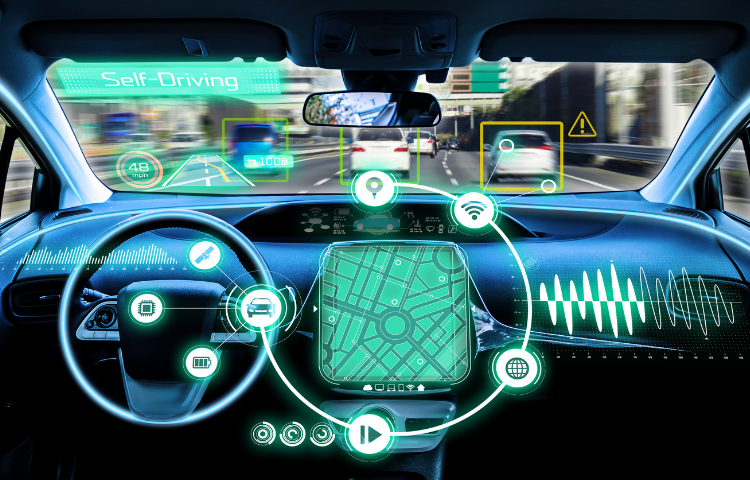

Prefer to listen instead? Here’s the podcast version of this article.
Previously, we have explored machine learning and its impact on small businesses. However, machine learning is integrated in many aspects of life. Let’s switch gears and explore the applications of machine learning in the context of our lives as consumers. The automotive industry commonly uses artificial intelligence to optimize the design and manufacturing of vehicles released to the market. One area where machine learning plays a critical role is in the advent of self-driving cars.
A handful of tech and car companies are currently racing to have their self-driving cars on the road first. The self-driving cars being developed rely on advanced technologies, including machine learning, to power these cutting-edge vehicles. So, before the day comes that you look in the rearview mirror and notice you are surrounded by self-driving cars, let’s go over the technology that propels these innovative cars.
Machine learning is at the center of self-driving cars. For a self-driving car to drive on the road, it utilizes specially designed hardware and software. The hardware continuously collects data from the surrounding environment, while the software takes the collected data and sorts it. The software then relinquishes the data to machine learning algorithms to process the data and make decisions.
With machine learning algorithms, the more data the algorithm is exposed to, the more intelligent the algorithm becomes. This is because the algorithms take what they learn from prior experiences, draw conclusions based on the data, and then perform the action that will result in the best possible outcome.
Machine learning algorithms in self-driving cars are fed data and process it in real-time. The machine learning algorithms analyze data, including everything from recognizing upcoming stop signs to identifying deer on the side of the road and cars braking ahead. The vehicle then interprets this data and decides the best course of action.
Also, it is important to note that machine learning is already utilized by certain cars on the market. For example, lane detection uses machine learning to monitor the lanes on the road. When machine learning detects the car is drifting out of its lane, it will either notify the driver or actually steer the car so it remains in the correct lane.
We can further break down the use of machine learning in self-driving cars into smaller segments. These segments are object detection, object recognition, and movement prediction. When machine learning algorithms in self-driving cars analyze data, the first step is to recognize an object. Once an object is detected, the algorithms then need to determine what exactly the object is. Lastly, the algorithm needs to determine if the object will potentially get in the car’s path.
For example, if the car recognizes an object and then determines it is a gas station on the side of the road, the car knows it can continue driving since the store will not move into its path. However, if the vehicle recognizes an object and then determines it is a kid riding a scooter, the car decides that the kid may ride out in front of the vehicle, and the car will slow down.
Machine learning in cars is also used for the next level of predictive maintenance. Currently, most drivers experience notifications when their vehicle requires maintenance, such as the check engine light illuminating on the dashboard. However, machine learning takes it a step further by discovering budding issues before they happen. Additionally, machine learning can also provide prescriptive alerts. The purpose of prescriptive alerts is “to produce outcome-focused recommendations for operations and maintenance.”
Essentially, prescriptive alerts determine when something is going to be an issue and then provides the solution, all before the issue actually arises. Examples of prescriptive alerts include notifying drivers when to change tires, replace brakes, and fix cooling systems. Prescriptive alerts and maintenance are extremely beneficial to the shipping industry and truck drivers. This is because drivers will not have to stop mid-trip to fix these issues which would delay the shipment, but instead can have their truck maintained ahead of time to avoid delays. Prescriptive alerts and maintenance are still new but are thought to be the next level of predictive maintenance.
One of the most significant issues with self-driving cars is making sure they collect enough real-world experience and data on public roads. It is a catch-22 because on the one hand, self-driving cars need to be on public roads to collect data and be exposed to real-world situations to improve accuracy and safety. However, allowing self-driving cars on public roads also puts the public’s safety at risk by exposing them to the emerging technology.
Self-driving cars are not expected to be widely available and legal to the public for years to come. The leading companies currently building and testing these vehicles have predominantly already passed their initial predictions of when the cars will be ready. Therefore, they are still perfecting the technology behind the wheel (if there even is a wheel). However, without machine learning, self-driving cars probably would not have made it this far in their development.
Machine learning is vital to the success and advancement of self-driving cars and is central to the vehicles’ operation. As advancements in machine learning are made, not only will self-driving cars improve, but so will countless other aspects of the publics’ everyday lives. From eCommerce to marketing and healthcare, machine learning will be innovating life as we know it.
Interested in developing more about machine learning and how it can apply to your business? Contact us at info@quantilus.com for a consultation and learn more about what Quantilus has to offer here.
WEBINAR